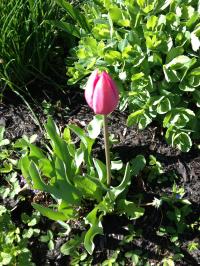
It feels like barbed wire across the heart to say goodbye to someone we love. What’s stronger than the pain? The memory of how this person made us feel.
Anyone connected to our Nova Scotia town or East Coast music needs no introduction to Fleur Mainville. But explain her to those who never had the privilege? That’s tough. Fiddler, singer, composer, recording artist, teacher, manager of our Farmer’s Market … her CV is pages long, without even touching on her role as wife, mother, daughter, sister, friend, mentor, role model, community advocate, and divine spirit. She was all of these things and more, not just the sum of her parts but the energy that brought them all to bear. To meet her was to marvel at how she did so many things at once and still managed a kind word, a thoughtful gesture, or one more gig.
And now that her body has been taken by a rare and virulent cancer, we are left with the barbed wire, grinding into us the awareness of what will be no more – her voice that carried notes of crystal across a background of velvet scores, her ability to coax from four simple strings a tidal wave of delights – knee-slapping reels, fierce stories of battle, winsome laments, intricate sonatas. Her squeals of delight that preceded her all-consuming hugs, her fierce pride in community and passion for the stage, and her investment in the future by passing on her knowledge and her enthusiasm to anyone of any age open to the message.
As we wade, gasping, through the grief, we are reminded that what made Fleur such a brilliant part of our lives was not her body or her deeds: it was how she made us feel. She had a way of making each of us in her presence feel talented, beautiful, and optimistic, just as she was. We loved her; she loved us first. And now, as we mourn a life gone too soon, we are reminded that throughout our time with her it was much the same. Every gig, meeting, lunch date or evening with her ended with a hint of sadness that begged for one more hour, five more minutes, just a few more words. Now, with her spirit set free, we have all the time in the world with those feelings she evoked in us. We have the memories of our lessons with her, the conversations, the teasing grin, and the warmth she spread from the inside out.
As I write this my son is preparing for his fiddle lesson – not to take, but to give. His student is age 8, the same age he himself was when he first picked up the fiddle. For half his life Fleur stood over him, then beside him as he grew to her height and then some, imparting her wisdom on trills and rests, then strathspeys and concertos, and finally lesson plans and drills as she nudged him out of her safe harbour and toward his own stage. As he coaches his young student, I hear more than his voice. I hear Fleur’s legacy.
We could not stop the disease that took her in body, but there is no stopping the spirit that will outlast and continue to live us all. The pain will ease for us as it has vanished for her. As the barbed wire tightens its grip, we can remember this and for me, for a moment, I smile with all my heart.


